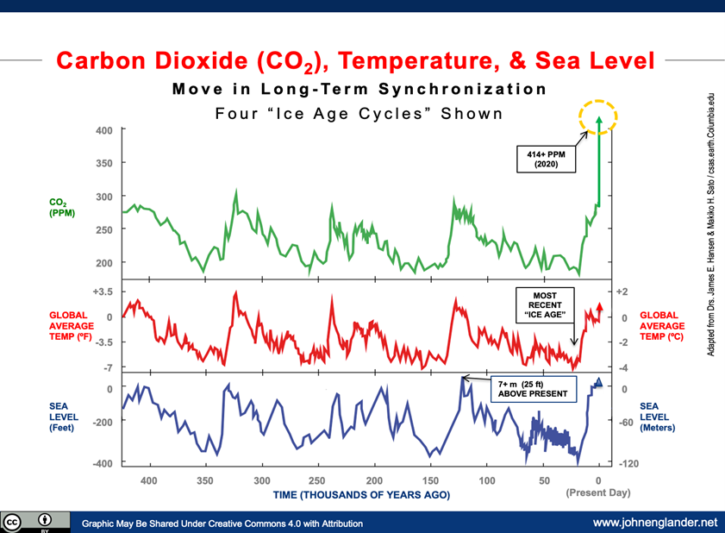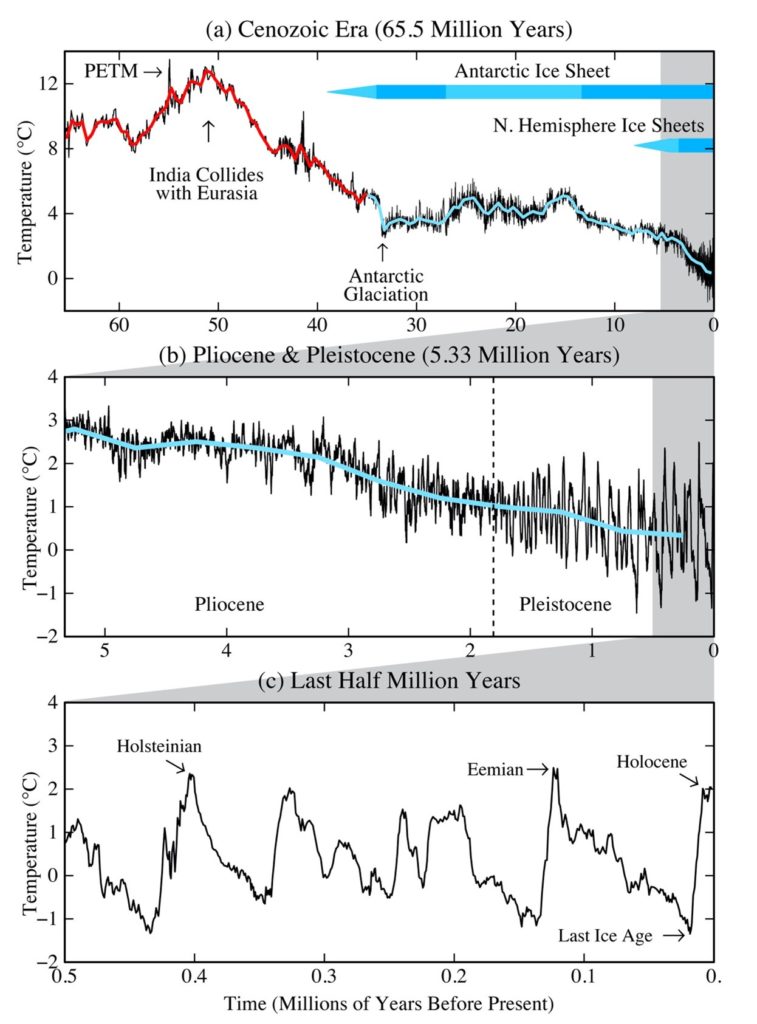(Additional info on page 9 in Moving to Higher Ground, © John Englander, 2021)
The idea that the ice sheets go through cycles of growth and retreat was first proposed in the 1830s by the legendary geologist, Louis Agassiz. It took almost a half century for the idea to be accepted as a fundamental principle of geology. Today, geologists define an ice age as any period when ice sheets and glaciers cover large masses of land. Given that the north and south poles both currently contain year-round ice, Earth is technically still in an ice age.
To keep things simple, I use the term “ice age” to describe the colder eras when thick ice sheets covered most of the Northern Hemisphere, though scientists may refer to these as glacial periods.
A century ago, Serbian scientist Milutin Milankovitch brilliantly identified the trigger agent for the ice age cycles. Now known as the Milankovitch Cycles, he theorized that the ice ages resulted from the combined effect of three cycles of Earth’s planetary movement: its varying elliptical orbit around the sun, its “tilt”, and its “wobble,” properly referred to as the eccentricity, obliquity, and precession. With more precise measurements, it is now generally accepted that the elliptical orbit is the dominant influence.

Figure 1: For thousands of years, CO2, global average temperature, and sea level have moved in close synchronization. The middle (red) graph depicts four ice age cycles. (Adapted from James Hansen / Makiko Sato)
Over the last 400,000 years, the red line (Global Average Temp) of Figure 1(repeated from the main text here for convenience) shows the heating and cooling repeating in the range of 95,000 to 125,000-year cycles. Sea level, global temperature, and CO2 all move in near-perfect synchronization.
These ice age cycles correlate precisely to the range of the orbital variation cycle.
The changing orbit that determines how far we are from the sun results in a one percent difference in heat received and is the main trigger for the ice-age pattern of the last few million years. Thus, we not only have a correlation of timing, but also a mechanism for causation.
Skeptics about climate science often say that correlation is not causation. However, when there is a known mechanism that can cause a result and it correlates with a wide range of observations, it is valid cause and effect and is scientifically accepted.
Earth’s 50-Million-Year Cooling Profile Leads to the “Ice Ages”
Thinking about the ice ages often leads to a related question: how long have they been occurring? The current heating and cooling cycles in which sea level moves up and down several hundred feet over 100,000 years, have been going on for just over 2.5 million years. Yet, even this ancient history is just a blink of an eye when compared of the overall 4.6-billion-year history of our planet.
Some people who are confused by climate change or want to dismiss it as something beyond our understanding, throw around assertions about sea level or climate “a billion years ago.” Looking back a billion years is of limited value and may actually add to the confusion. Today’s continents didn’t exist then, the oceans had a very different configuration, and there was very little oxygen in the atmosphere. In other words, there was very little similarity to the world as we know it.
Whether there was ever a time when Earth was colder, forming a so-called “snowball Earth” in which glaciers reached the equator, is a matter of some controversy. But scientists agree that some more distant very cold periods occurred one or two billion years ago, a very early stage in the development of the planet. And, at its most extreme, sea level has varied at least 600 feet (some 200 meters) over our entire geologic history.
Until the Cambrian explosion 540 million years ago, life forms were very primitive, mostly single-celled organisms, and the atmosphere would not have supported higher life forms, including humans.[1]
Over the last several hundred million years the continents slowly moved from the single southern hemisphere land mass, known as Gondwana or Pangaea, to their present positions. The migration of these land masses into the northern hemisphere slowly changed the Earth’s climate.
Figure 2 depicts temperature changes over the past 66 million years and is based on isotope analysis of temperature markers, primarily from deep sea sediment cores.

Figure 2: Earth's temperature profile. The top section (a) depicts 66 million years to present, with sections (b) and (c) expanding the recent five million years and last 500,000 years with more detail. (Courtesy Dr. James E. Hansen).
We can think of the last 66 million years, the Cenozoic Era, as having three phases:
1) A warming phase from 66 million years ago, peaking 50 million years ago;
2) A cooling phase from 50 million years ago, until it leveled off 2.5 million years ago (the Pliocene epoch), and;
3) The 2.5 million years of ice age cycles (the Pleistocene epoch) that has persisted until rather recently, in geologic time.
The warming phase began after a massive asteroid hit Mexico’s Yucatan Peninsula, killing three quarters of all life on Earth, most famously, the dinosaurs. That extinction is known as the Cretaceous–Paleogene (K–Pg) or Cretaceous–Tertiary (K–T) extinction. It is the most recent of the five major known extinctions, and the only one that is widely accepted to be triggered by an extra-terrestrial cause.
The cause for the warming spike, known Paleocene-Eocene Thermal Maximum, or PETM, is not clear, but huge volcanic events and methane are high on the list of suspects (See Note #9 for more on methane).
Temperature peaked around 50 million years ago. Then, over millions of years, the land that is now the Indian subcontinent “slammed” into Asia. In super slow motion, the earth buckled upwards, five miles high, creating what we now know as the Himalaya Mountains. The creation of these enormous peaks had a transformative effect on planetary weather patterns, creating year-round mountain snow cover, and changing global air currents like the Jet Stream. This was the start of a long-term cooling trend.
The last five million years, the middle section of the graphic, shows the trend towards the ice ages. You can see that between three and four million years ago, the Earth started to hit a natural harmonic of oscillating climates, heating and cooling cycles every 90,000 to 120,000 years, following the Milankovitch Cycle.
But it wasn’t until the last two and a half million years, known as the Pleistocene or the Quaternary, that glacial cycles were fully established. And the last several hundred thousand years have created a climate stable enough to support our species. Science now has good evidence that humans have been present for hundreds of thousands of year at least.
During the most recent cold period (“glacial maximum”) some 20,000 years ago, ice sheets and glaciers more than a mile-high extended south as far as the middle of modern North America, Europe, and Asia. During this glacial period, the ocean was as much as 390 feet (120 meters) below present sea level, the equivalent of a typical 30-floor building.
Other Influences On Climate
While the Milankovitch Cycle is arguably the most powerful influence on climate, we should not overlook some other physical changes that have had significant effects on weather and climate.
The connection of North and South America, separating the Atlantic and Pacific oceans, is one example. The Isthmus of Panama was created 2.8 million years ago when the Earth’s plates collided. This, in turn, caused some major earthquake and volcanic activity. When ocean flow from the Pacific to the Atlantic was halted by the formation of what is now Panama, ocean currents changed markedly. The effect on global weather patterns was dramatic, creating the Gulf Stream in the Atlantic and the Humboldt Current in the Pacific, which are dominant factors for weather and fisheries.
[1] Peter D. Ward, Out of Thin Air: Dinosaurs, Birds, and Earth’s Ancient Atmosphere, (Washington, DC: Joseph Henry Press, 2006).
Deeper Dive Notes
Dive Note 1
Dive Note 2
Dive Note 3
Dive Note 4
Dive Note 5
Dive Note 6
Dive Note 7
Dive Note 8
Dive Note 9
Dive Note 10
DOWNLOAD
PDF (ALL)